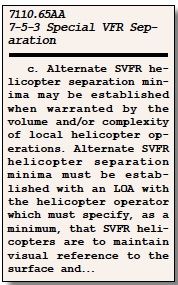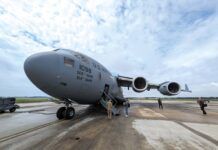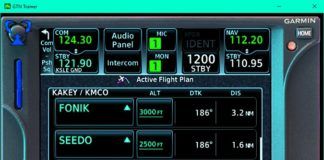Special VFR (SVFR) is a clearance that pilots can use to fly VFR into an airspace reporting below VMC. SVFR allows pilots to operate in and out of Class B, C, D, or E airspaces below 10,000 feet when the reported weather is below normal VFR. It is a great tool when used correctly, and frees a pilot from needing an IFR clearance when they can maintain special VFR conditions for a short time. You should understand SVFR, but also evaluate it critically in terms of your own capabilities and limitations.
Depending on the facility, ATC will provide the appropriate service for SVFR aircraft when operating near IFR aircraft. In the tower, we treat SVFR aircraft (lacking a Letter of Agreement, LOA) similar to IFR aircraft due to the low-visibility permitted for SVFR. The best way we remember it is, “One in, one out.”
We’ll discuss the LOA aspect a bit later. Of course, there is a process. SVFR is normally approved or refused based on IFR traffic present. If absolutely nothing is going on, it’s not normally a big deal to approve SVFR requests. Note that SVFR clearances can be revoked by ATC as needed to move IFR traffic.
If someone is trying to do a photo mission while it’s OVC009, and they are essentially loitering in the airspace, yet there are several arrivals/departures that need to move, that SVFR will be stopped and asked to either land or exit the airspace until IFR aircraft are accommodated. If you’re simply trying to transition and you obtain SVFR, at controller discretion it might be more beneficial for ATC to just let you pass, and then continue to work the IFR traffic. But, IFR aircraft have priority over SVFR aircraft.
In areas where Radar and ARTCC controllers are allowed to accept or decline SVFR, their rules are a tad different. Because it might become difficult to separate an SVFR on an unknown path from an IFR on a prescribed path, they will generally treat the SVFR like an IFR airplane. If necessary, they will give restrictions to ensure the SVFR aircraft will not interfere with other traffic.
Any pilot who’s flown visually with only one statue mile of visibility, knows this can be difficult. Because of the potential to essentially tie ATC’s hands, SVFR approval is entirely at the controller’s discretion. From the 7110.65, 7-5-2: “SVFR flights may be approved only if arriving and departing IFR aircraft are not delayed.” Since a radar controller’s primary job is handling IFR aircraft, they are more likely to deny SVFR depending on workload.
SVFR Separation
I mentioned that ATC might treat SVFR aircraft like IFR aircraft. Why? One of the first separation requirements is to “apply non-radar or visual separation.” Visual separation is not always possible for a radar controller. If the ceiling is high enough, we can apply visual in the tower with ease. It still requires one in and one out most the time, but it is possible. The basic principle says to apply separation between SVFR fixed-wing aircraft, SVFR fixed-wing and SVFR helicopters, and SVFR fixed-wing and IFR aircraft. Those first two would apply if a controller had more than one SVFR operating at once, and the third is the most common.
Helicopters are different. (You knew that, right?) Our requirements for them are quite different. This is where the LOA comes in handy. See 7110.65AA, section 7-5-3.
As you can see, we have a lot more flexibility moving SVFR helicopters compared to fixed wings. This excerpt is intended for Tower, so it really helps us keep things moving. Half a mile is all we need to keep ’em separated. With an LOA established, helicopter pilots understand our requirements, so it makes it easier to work together during those conditions. Lacking an LOA, you might sometimes be kept up to a mile away.
When?
Let’s review the pilot requirements. Pilots requesting SVFR during the day need to have at least a Private and must maintain one mile visibility and remain clear of clouds. In addition, at night, the pilot and airplane must be IFR capable. For ATC, SVFR is only authorized within the lateral boundaries of Class B, C, D, and E surface areas below 10,000 feet, on the basis of weather conditions reported at the airport of intended landing/departure. SVFR must be requested by the pilot; ATC can neither solicit nor offer SVFR. Also, note that Sectional charts show some airports where SVFR is not authorized.
The best example of when SVFR is appropriate, is when a pilot wants to land at a Class B, C, D, or E airport, they can see the field, but it’s reporting below VFR, BKN009, for example. They can see through or between the clouds, and they’re confident they could get in visually. An SVFR clearance request is ideal to get in. Or a pilot might request SVFR to depart the airport in similar conditions.
Sometimes the ASOS/AWOS or other weather reporting equipment doesn’t quite match the actual conditions, and a human being is needed to make a determination. This can happen when the equipment is on a part of the airport where the conditions are different. While this seldom happens, it does occasionally happen. If I’m working and it reports IMC from a small, localized influence while the rest of the airport is good, I’m going to do what I need to help pilots get where they need.
With that said, there are times that I will not even entertain a SVFR clearance, if the reasons are obvious. The field could be socked in IFR, VV001, visibility well under a mile, etc. Other reasons might include something going on that cannot be discussed on frequency, any kind of accident/incident, or when visual conditions cannot be maintained. Keep in mind, I’m speaking from a Class D (VFR Tower) environment. If I can’t keep you in sight from the tower, I can’t apply that visual separation, so I would have to deny or revoke SVFR.
When all else fails, and you and your airplane are qualified, why not just pick up an IFR clearance? Even getting a preflight weather brief and doing your proper research, sometimes the clouds have something else in store. It’s happened to me at work and while flying more times than I care to remember. While an SVFR clearance could be a lot easier than asking for and getting a long IFR clearance while flying, SVFR just might not be the safest course of action. Even though there’s no instrument-rating requirement during the day, I personally recommend that VFR-only pilots avoid SVFR. See a cloud? Go around.
LOA
When an LOA is established, it could mean a variety of different things based on who writes it and what they are trying to get out of it. For the Class D where I work, LOAs concerning SVFR are solely for the helicopter operations in and out of the field, and they all have a section pertaining to SVFR. Our LOA establishes the criteria and explains the ATC rules so we are all on the same page.
They know if they are doing pattern work SVFR, we can recall them or hold them on the ground if our separation requirements will not be met. Of all the time I’ve worked the helicopters SVFR, I’ve never had to hold them longer than a minute. It’s also a plus for us because in our separate LOA with Aproach Control, we reiterate that we don’t have to call and ask for SVFR permission for those on an existing LOA with the Tower. It saves a little bit of coordination. If the airport is under IFR conditions, us “VFR” tower controllers don’t do much since approach owns the airspace.
If an LOA is not established or the concerning airspace does not have an operational control tower, it’s the one in one out game. This could be why if you’re trying to depart a nontowered field IFR, you could end up having to wit a while to depart, especially if the arrival doesn’t call ATC or FSS to cancel IFR.
Be Safe
So, yes, SVFR is a great tool when used correctly. The main issue I’ve seen in my time as a tower controller is when pilots attempt to utilize it, but dig themselves into a hole or end up going IMC. Honestly, if you’re not a proficient instrument-rated pilot, I wouldn’t recommend it at all. If your flying doesn’t require an instrument rating, get some good dual instruction and know your limitations before even thinking of asking for SVFR. ATC is happy to help as much as possible, but not if it will potentially get either of us in a difficult situation. Do fly safe now, ya hear?
At his VFR tower, Elim Hawkins will approve your SVFR request whenever it’s safe to do so.





